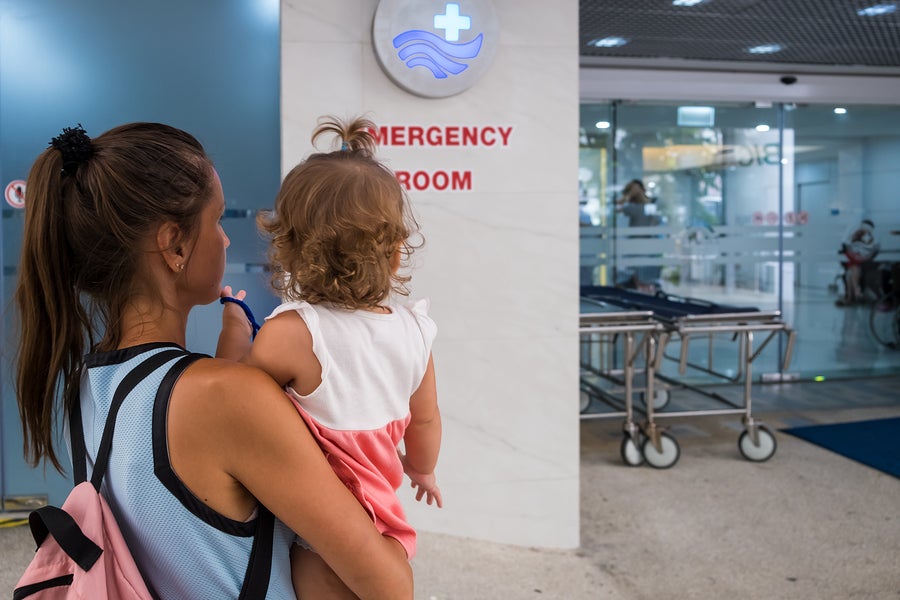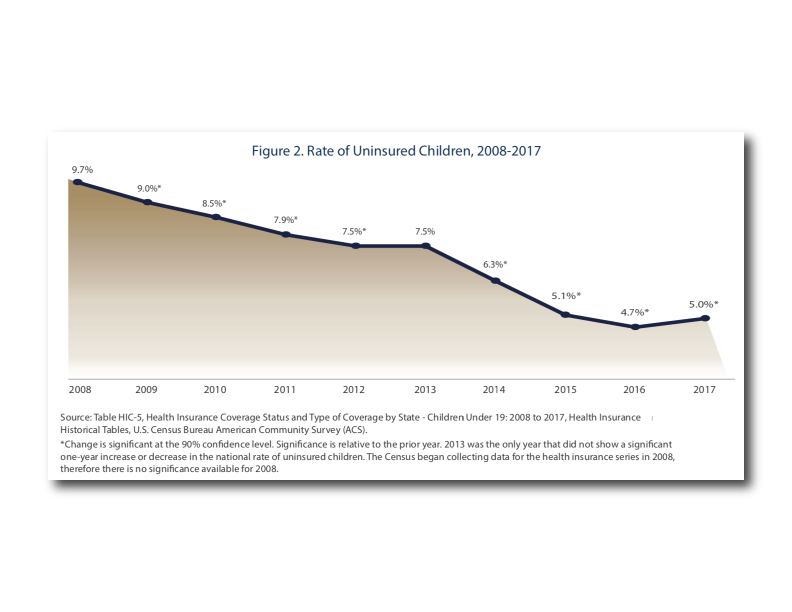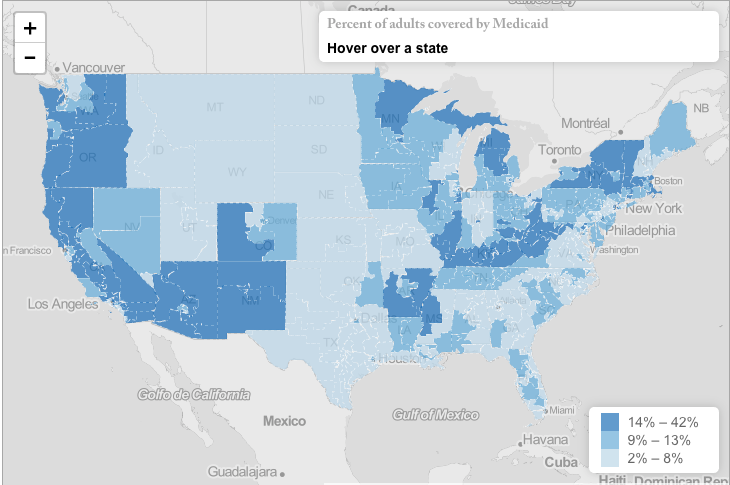Missouri
-
States that Expanded Medicaid are Helping to Protect Children from Becoming Uninsured
Our annual report on the state of children’s coverage is out. It’s a deep dive into a disturbing trend – children across the country are losing affordable health coverage, rolling back gains started with the Affordable Care Act. One main cause of this drop in coverage is easily fixed. The 14 states that haven’t expanded…
-
National Decline in Child Enrollment in Medicaid and CHIP Slows but Steep Declines Continue in Problem States
In the first four months of 2019, overall child enrollment in Medicaid and CHIP dropped by 122,000 children with declines in 31 states offset by gains in 20 states. As noted in previous blogs and this report, the largest declines are occurring in a handful of states. States with the Largest Percentage Decline – In…
-
New Data Show Widespread Decline in Child Enrollment in Medicaid/CHIP Coverage in 2018
We’ve been anxiously awaiting the release of final Medicaid and CHIP enrollment data for 2018, which was expected to be posted almost a month ago. The wait is finally over but not our concerns about what’s happening. In the meantime, more stories about eligibility system issues in a handful of states and states conducting more…
-
2016 Maps
The interactive maps and data for 2016 provide information on the percent of adults and children covered by Medicaid and/or CHIP.You can embed these maps on your website by selecting a state on the left then copying the embed code on the right side of the map and pasting it into a post on your…
-
Rate of Uninsured Children Worsens in Missouri, Nationwide
Missouri News Service By: Suzanne Potter About 75,000 children in Missouri lacked health insurance in 2017, or about 5.1 percent, according to a new report from Georgetown University’s Center for Children and Families. That’s a small increase over 2016 and is just above the national average, which increased from 4.7 to 5 percent. The report…
-
Nation’s Progress on Children’s Health Coverage Reverses Course
Introduction For the first time since comparable data was first collected in 2008, the nation’s steady progress in reducing the number of children without health insurance reversed course. The number of uninsured children under age 19[note] This report examines children under age 19 because of changes to the health insurance age categories in the 2017…
-
Missouri’s rural residents need better health care options
St. Louis Post-Dispatch By: Aaron Griffin and Jen Bersdale There are people all across Missouri who are struggling to access health care, but the situation is much worse for those living in rural communities and small towns. While about a quarter of Missourians living in metro areas like St. Louis and Kansas City are uninsured,…
-
Rural Communities Lack Progress in Reducing Rate of Uninsured – Report
Missouri News Service By: Stephanie Carson Missourians in the rural parts of the state have a harder time accessing health care, compared to some neighboring states, according to a report released this week by the Georgetown University Center for Children and Families. The analysis shows that states that expanded Medicaid saw more than three times…
-
Is there renewed hope for Medicaid expansion in Missouri?
St. Louis Post-Dispatch By: Samantha Liss Health care advocates in Missouri are closely watching successful efforts to put Medicaid expansion on the ballot in other red states. Last year, voters in Maine approved expanding Medicaid through a ballot initiative, the first state to gain approval through a public vote. … “Interestingly, Medicaid has always polled…
-
State Medicaid and CHIP Snapshots, 2018
The Georgetown University Center for Children and Families (CCF) and the American Academy of Pediatrics (AAP) created factsheets underscoring the importance of Medicaid in providing coverage for children in all 51 states (including the District of Columbia). Sources are available here. Previous snapshots can be found here.
-
Nationwide Rate of Uninsured Children Reaches Historic Low
Nationwide 95.5 percent of children had health insurance in 2016, up from 95.2 percent the previous year—and up from 92.9 percent in 2013, the year before the ACA was fully implemented. While relatively few children rely on the ACA’s Marketplace for insurance, many gained coverage in Medicaid or CHIP when their parents signed up for…
-
Section 1115 Medicaid Waiver Comments
Georgetown University’s Center for Children and Families contributes an independent perspective to the public dialogue on the future of Medicaid through the lens of children and their families.
-
State CHIP Snapshots
The Role of CHIP in Children’s Coverage In 2016 the children’s health insurance coverage rate in the United States dropped to just above 95 percent, an impressive achievement. Key to this success is the Children’s Health Insurance Program, which provides coverage to children who do not qualify for Medicaid but whose families cannot otherwise afford…
-
INTERACTIVE MAPS: Children Covered by Medicaid and CHIP by county, state or congressional district.
These maps show how many children are covered by Medicaid in each county and congressional district. Visit these links to view the maps, and to download handouts on your state’s coverage data: Percent of Children Covered by Medicaid/CHIP (congressional district) Percent of Children Covered by Medicaid/CHIP (county) Visit CCF’s State Resource Center for state-level data on health…
-
Report Suggests Improved Outreach and Enrollment Efforts Directed at Very Poor Parents Needed
As I was flying back from Atlanta the other night, I read a fascinating new paper by researchers at the Urban Institute (a team led by the esteemed Genevieve Kenney), which looks at adult uninsured rates and participation rates in Medicaid. In particular, the researchers examine how the number of uninsured parents and childless adults…
-
More on that HHS QHP-CHIP Comparison
My last blog before maternity leave was on the release of HHS’s certification summary, or the results of the agency’s Congressionally mandated comparison of CHIP with the qualified health plan (QHP) coverage children receive. My first blog since returning to work full time is on the same topic—in late May, HHS’s Office of the Assistant…
-
Medicaid Expansion is Having Positive Ripple Effects
(Editor’s Note: You can hear the recording of our press call releasing the report here.) By Adam Searing and Jack Hoadley The 19 states that continue to decline federal funding to offer Medicaid coverage to more uninsured residents are missing out on more than just improvements to their uninsured and uncompensated care rates. In fact,…
-
Beyond the Reduction in Uncompensated Care: Medicaid Expansion Is Having a Positive Impact on Safety Net Hospitals and Clinics
More than two years after the onset of expanded Medicaid coverage, significant differences are emerging between states that opted to expand Medicaid and those that did not. This report contains the findings of telephone interviews with eleven leaders of hospital systems and federally qualified health centers (FQHCs) in seven states. Three of the states where we conducted interviews…
-
Missouri’s Health Reform Assisters Triumph In Court
By Emily Curran, Georgetown University Center on Health Insurance Reforms Health reform advocates experienced a win last month, when a federal court in Missouri struck down three sections of a recently enacted state law that interfered with the ability of consumer assistance personnel to help Missourians understand their health insurance options and enroll in coverage.…
-
Federal Court Ruling: Navigator Laws Cannot Impose Additional Requirements on Navigators and Other Assisters in Federal Marketplace States
A federal district court ruling yesterday regarding Missouri’s navigator law has the health coverage community abuzz. As I noted in this Say Ahhh! blog, a number of states have proposed or passed legislation to require additional training and licensing for navigators, and sometimes other assisters, and restrict the activities they are required to perform by…











